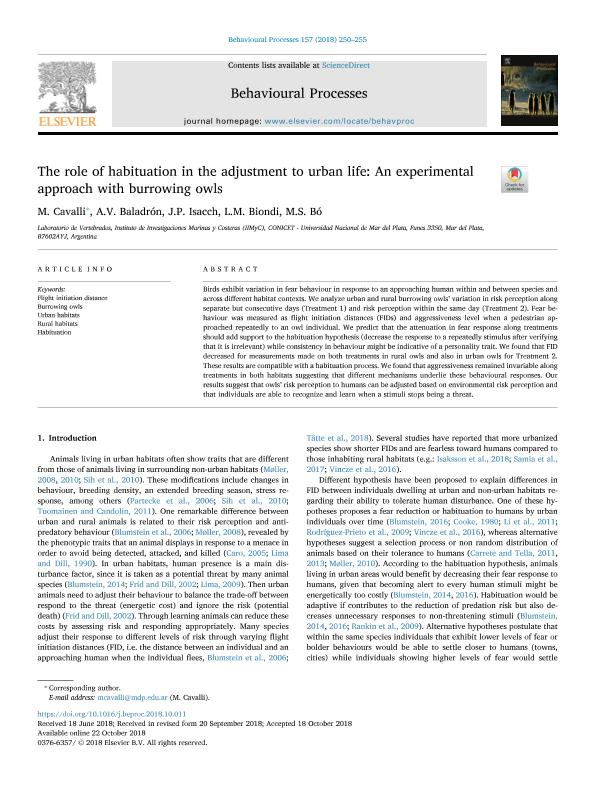Artículo
The role of habituation in the adjustment to urban life: An experimental approach with burrowing owls
Cavalli, Matilde ; Baladron Felix, Alejandro Victor
; Baladron Felix, Alejandro Victor ; Isacch, Juan Pablo
; Isacch, Juan Pablo ; Biondi, Laura Marina
; Biondi, Laura Marina ; Albornoz, Maria Susana
; Albornoz, Maria Susana
 ; Baladron Felix, Alejandro Victor
; Baladron Felix, Alejandro Victor ; Isacch, Juan Pablo
; Isacch, Juan Pablo ; Biondi, Laura Marina
; Biondi, Laura Marina ; Albornoz, Maria Susana
; Albornoz, Maria Susana
Fecha de publicación:
12/2018
Editorial:
Elsevier Science
Revista:
Behavioural Processes
ISSN:
0376-6357
e-ISSN:
1872-8308
Idioma:
Inglés
Tipo de recurso:
Artículo publicado
Clasificación temática:
Resumen
Birds exhibit variation in fear behaviour in response to an approaching human within and between species and across different habitat contexts. We analyze urban and rural burrowing owls’ variation in risk perception along separate but consecutive days (Treatment 1) and risk perception within the same day (Treatment 2). Fear behaviour was measured as flight initiation distances (FIDs) and aggressiveness level when a pedestrian approached repeatedly to an owl individual. We predict that the attenuation in fear response along treatments should add support to the habituation hypothesis (decrease the response to a repeatedly stimulus after verifying that it is irrelevant) while consistency in behaviour might be indicative of a personality trait. We found that FID decreased for measurements made on both treatments in rural owls and also in urban owls for Treatment 2. These results are compatible with a habituation process. We found that aggressiveness remained invariable along treatments in both habitats suggesting that different mechanisms underlie these behavioural responses. Our results suggest that owls’ risk perception to humans can be adjusted based on environmental risk perception and that individuals are able to recognize and learn when a stimuli stops being a threat.
Palabras clave:
FLIGHT INITIATION DISTANCE
,
BURROWINGS OWLS
,
URBAN HABITATS
,
RURAL HABITATS
Archivos asociados
Licencia
Identificadores
Colecciones
Articulos(IIMYC)
Articulos de INSTITUTO DE INVESTIGACIONES MARINAS Y COSTERAS
Articulos de INSTITUTO DE INVESTIGACIONES MARINAS Y COSTERAS
Citación
Cavalli, Matilde; Baladron Felix, Alejandro Victor; Isacch, Juan Pablo; Biondi, Laura Marina; Albornoz, Maria Susana; The role of habituation in the adjustment to urban life: An experimental approach with burrowing owls; Elsevier Science; Behavioural Processes; 157; 12-2018; 250-255
Compartir



